|
by Joan Peterson This article first appeared in the Winter 2009 quarterly newsletter--Repast--published by the Culinary Historians of Ann Arbor. ![I, Noumenon [GFDL (http://www.gnu.org/copyleft/fdl.html), CC-BY-SA-3.0 (http://creativecommons.org/licenses/by-sa/3.0/) or CC BY-SA 2.5 (https://creativecommons.org/licenses/by-sa/2.5)], from Wikimedia Commons](/uploads/2/4/6/1/24613670/unhelvasi_orig.jpg) Photo attributed to I, Noumenon. Photo attributed to I, Noumenon. Halvah (helva) is the oldest type of dessert in Turkish cuisine writes noted Turkish culinary expert, Nevin Hal]c], in her book Turkish Cookery; the earliest known recipe for halvah dates to the 11th century. The name is derived from the Arabic root hulw, or halwa, meaning sweet, and describes a large family of confections in the Middle East, Central and South Asia and the Balkans. Halvah has three basic ingredients: a starch, a fat and a sweetener. It most commonly is made with semolina, but several other distinct versions of halvah exist. To prepare this sweet, semolina (or equivalent) typically is toasted or fried while constantly stirring it with a wooden spoon, sometimes together with butter, until golden brown. Liquid, scalded milk for example, is then mixed in, along with sugar or reduced grape juice (pekmez) and melted butter. Frequently almonds, pine nuts or pistachios are added for flavor. The writings of the Islamic mystics, the Sufis, provided considerable insight into the nature of Turkish cuisine in the 13th century. One of the most renowned mystics and poets was Mevlânâ Celâleddin Rûmî, founder of the Mevlevî (whirling dervish) order. Rûmî’s poems record the importance of food in the life of the religious order and contain many references to the foodstuffs available in Selçuk Anatolia, including halvah. The language of food typically was symbolic; allusions to food signified spiritual sustenance, and its processing the purification of the soul. Besides its frequent mention in Sufi literary works, halvah also became an important part of the Sufi religious ceremony. Considered a most delectable mortal food, halvah was equated with the sweetness of spiritual rapture and was eaten at the end of the ritual where a spiritual merging with the divine was sought by repeated invocation of a holy chant. Halvah’s importance grew during the Ottoman period. The fragmentation of the Selçuk empire in Anatolia paved the way for independent Turkish bands to carve up the former Selçuk state into smaller, rival fiefdoms. The Ottomans swept away all challengers over a period of about two centuries and in 1453 they snatched the coveted prize of Constantinople (now Istanbul) from the Byzantines and added it to the sultanate. Sultan Mehmet II the Conqueror wasted little time erecting the splendid Topkapâ Palace in Istanbul shortly after he took over the city. Judging from the huge kitchen it housed, topped with four large domes, it was apparent that culinary arts played a major role in daily affairs. In fact, Turkish cuisine under the tutelage of the Ottoman sultans flourished at the hands of many skilled cooks anxious to please them and gain promotion. These cooks not only had their culinary heritage to draw upon, but had access to just about every existing ingredient in the vast empire of the Ottomans. These exotic foodstuffs and spices became a part of an ever growing repertoire of dishes that appeared in the sumptuous, multiple-course meals presented to the sultans. All the while, the size and complexity of the kitchen staff increased to feed the growing number of people living on the palace grounds. At the end of the 16th century, according to the imperial records, a staff of 200 live-in cooks toiled in the kitchen. In a mere 50 years, this number rose to about 1,400. They fed up to 10,000 people in a single day, including those meals destined for diners outside the palace as a token of the sultan’s favor. To accommodate this flurry of culinary activity, the kitchen was enlarged during the reign of Süleyman the Magnificent (1520–1566). The imperial architect, Sinan, added the 6-domed Has Mutfak and Helvahâne (literally, the “house of halvah”). Sweets, especially halvah, fruit conserves, syrups and macun, jelly-like pastes claimed to have healing effects, were made in the Helvahâne. Some years later, the kitchen underwent a doubling in size with the addition of 10 more sections. The organization required for a culinary operation of this size to run smoothly was staggering. Every imaginable food category had not one, but an entire staff of cooks devoted to the art of preparing and perfecting it. For halvah, six versions were made, each requiring a chef and a hundred apprentices. All food personnel were part of a complex infrastructure. At the top was the matbah emini, the trustee of the royal kitchens. The hierarchy also included a prodigious administrative staff that oversaw the purchase, storage, preparation and serving of tons of foodstuffs arriving at the palace kitchen each year. By royal decree of Sultan Mehmet II the Conqueror, all civilian and military people wore outer garments and turbans of a specific style and color to facilitate recognition of their vocation and position within the hierarchy on sight. The culinary staff of the palace was not immune to this edict, and a rich variety of garments and styles characterized these jobs. The abundance of food and the quality of dining outside the palace grounds was in the hands of special guilds, about 43 of them, which regulated the cost and quality of the food. At the hub of this effort was the indoor Egyptian Market, still in existence today, which housed a vast selection of foodstuffs in addition to spices and herbs, and provided for the whole city of Istanbul.
The trade guilds were instrumental in establishing the important social gatherings called helva sohbeti (halvah conversations). Family and friends would get together during the winter months for conversation, games and dining. At the end of the evening, after the meal was finished, halvah would be served, which explains why the name became associated with these events. Usually those gathered would eat either veteran’s halvah (gaziler helvas]) made with flour and flavored with almonds, semolina halvah (irmik helvas]) or keten helvas] (floss halvah), whose texture is similar to cotton candy. Guests worked together to make the cotton candy, pulling and kneading the cooked syrup until it acquired a floss-like consistency. To cut its sweetness, this halvah was eaten with pickles! The tradition of the helva sohbeti all but ended in the nineteenth century when the trade guilds went out of existence. Halvah has long been associated with commemorative occasions, both happy and sorrowful, and this tradition still remains strong in Turkish culture. It is served wherever people gather to recognize births, circumcisions and weddings, among others, and to mourn deaths. This sweet is also an important component of religious ceremonies and feast days. In Turkey, circumcision is a significant event that traditionally occurs when boys are between five and seven years old. Even today celebrations of this ritual include entertainment and a feast. Those for the Ottoman princes were characterized by extravagance and profusion. A vast number of guests were invited to the festivities, which went on for days, even weeks. The enormity of a royal circumcision party from a food perspective can be appreciated from the palace kitchen records of the celebration in 1539 for Sultan Süleyman the Magnificent’s sons, Cihangir and Bayezid, which provided posterity a rarely so detailed description of the menu for such a grandiose event. According to the register, twenty tables—each with twenty-seven serving dishes, six pans and fourteen trays—were necessary to showcase just the sweets. Eight varieties of halvah were named among the confections: halvah with nuts (f]st]k helvas]), two almond halvahs presumably made with whole nuts (badem helvas] and levzîne helva), an almond halvah made with crushed nuts (kirma badem helvas]), cotton candy-like halvah (pe}mine; known today as pi}maniye), halvah flavored with saffron (sar] helva), wheat-flour halvah possibly flavored with rose water and cinnamon (residiye) and red halvah (k]z]l helva). The Sultan’s largesse for a royal circumcision commemoration extended far beyond his family and guests. As a part of the celebration, up to ten thousand boys from poor families were circumcised and given gifts of food and clothing. References Algar, Ayla. Classical Turkish Cooking: Traditional Turkish Food for the American Kitchen. New York: HarperCollins Publishers, 1991. Algar, Ayla. Food in the Life of the Tekke. In The Dervish Lodge: Architecture, Art, and Sufism in Ottoman Turkey, edited by Raymond Lifchez, pp. 296–303. Berkeley: University of California Press, 1992. Arsel, Semahat. Timeless Tastes: Turkish Culinary Culture. Istanbul: Divan, 1996. Hal]c], Nevin. Nevin Hal]c]’s Turkish Cookbook. London: Dorling Kindersley, 1989. Hal]c], Nevin. Sufi Cuisine. London: SAQI, 2005. Peterson, Joan. Eat Smart in Turkey: How to Decipher the Menu, Know the Market Foods & Embark on a Tasting Adventure, 2nd edition. Madison, WI: Ginkgo Press, 2004. Schick, Irvin. Personal communication. Schimmel, Annemarie. The Triumphal Sun: A study of the Works of Jalaloddin Rumi. London: East-West Publications, 1980.
4 Comments
The culture of Jordan is based in Arabic and Islamic elements with significant Western influence. Jordan stands at the intersection of the three continents of the ancient world, lending it geographic and population diversity. Jordan gets its culinary influences from North Africa, the Middle East, Persia, and the Mediterranean. This region is commonly known as the Levant. Jordan’s cuisine shares many of its traits with the cuisine of Lebanon, Palestine, and Syria. More generally, the cuisine is influenced by historical connections to the cuisine of Turkey and the former Ottoman Empire. Internationally known foods which are common in Jordan include hummus, tahini, and falafel. A typical mezze (small dishes served at the beginning of multi-course meals) includes kibbeh (a dish made of bulgur, minced onions, and finely ground lean beef, lamb, goat, or camel meat shaped into balls or patties), labneh (strained yogurt), baba ghanoush (cooked eggplant mixed with tahina, olive oil, and various seasonings), tabbouleh (a vegetarian salad made of tomatoes, finely chopped parsley, mint, bulgur, and onion, and seasoned with olive oil, lemon juice, and salt), olives and pickles. Bread, rice, and bulgur all have a role in Jordanian cuisine. Jordan is one of the largest producers of olives in the world so olive oil is the main cooking oil. Herbs, garlic, onion, tomato sauce, and lemon are typical flavors. Following is a short list of foods and flavors we discovered as we traveled through Jordan: Za’atar is a spice blend of oregano, basil, thyme, and savory, traditionally dried and mixed with salt, sesame seeds, and sumac. It is commonly eaten with pita. Za’atar is also used as a seasoning for meats and vegetables. A traditional breakfast would have it eaten with labneh, a yogurt that has been strained to remove most of its whey, and bread and olive oil for breakfast. 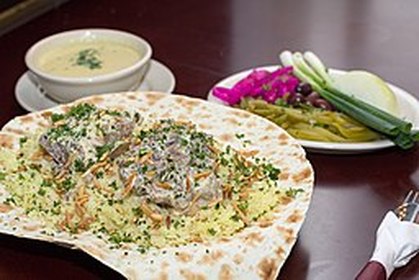 The national dish of Jordan is Mansaf, a dish made of lamb cooked in a sauce of Jameed (fermented dried yogurt) and served with rice or bulgar. The name of the dish comes from the term “large tray” or “large dish.” The original Bedouin mansaf was originally made with simple meat, broth or ghee, and bread. Following the popularization of rice in northern Jordan in the 1920’s, rice was gradually introduced into the dish, at first mixed with bulgar, and later on its own, until the dish reached its modern incarnation of being based on white rice. 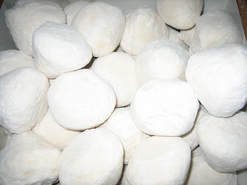 Jameed is a hard, dry yogurt that is prepared by boiling milk, either sheep or goat, and then left to dry and ferment. The mixture is later kept in fine cheesecloth to make a thick yogurt. Salt is added daily, which continues to thicken the yogurt until it is very dense and shaped into round balls. It is then set in the sun to dry for a few days. Falafel, is a combination of ground chickpeas, mixed with a variety of spices, shaped into mini patties, then deep-fried. It is one of the most common street foods or light meals in Jordan. It can be eaten as a snack, with bread, or stuffed into sandwiches. Zarb is a Bedouin version of barbecue, made by roasting lamb, chicken, and vegetables over hot embers and stones in a sand pit. Maqluba, meaning upside down, is a dish of spiced rice and chicken which is cooked in an earthen pot that is flipped upside down before being dished out. It will be found in most restaurants across the country and can be prepared with za’atar, cinnamon, or toasted almonds. Hareeseh is a dessert made with semolina, coconut, cream, sugar, yogurt, and almonds, all baked in a bar form until golden brown. It is very sweet, and has a slight floral taste to go with the grainy texture of the semolina. Kanefeh is a dessert popular throughout the Levant, especially known in Palestine and Jordan. Cheese is the most noticeable ingredient, which is paired with either noodles or semolina, drenched in a rose scented syrup, and topped with ground pistachios.
On our trip to Jordan we discovered the importance of generosity and hospitality and the significance of food in the Jordanian culture. Jordanians serve family, friends, and guests with great pride, no matter how modest their means. We will be leading our premiere Culinary Tour to Jordan in 2018. And while this tour has since filled, please make sure to look for our next tour in 2019. On February 22, 2018 we teamed up with vomFass/Delectable in Madison for a Dinner with the Authors. Local chef Edward Chwae created five dishes inspired by recipes included in our culinary travel guide, Eat Smart in Portugal. Authors Ronnie Hess and Joan Peterson talked about the history of the cuisine of Portugal and gave detailed descriptions of each dish's regional significance. Each dish was paired with a Portuguese wine or Port. It was a fabulous evening of food and conversation. And we look forward to our next event!
Photos by Susan Chwae, Ronnie Hess, Tim Walsh, Jeannie Manthe, and Saul Glazer. As we enter our 25th year of Ginkgo Press and Eat Smart Culinary Travel, we will devote a part of our blog to tell the stories of its team. We begin with Joan Peterson, Founder and President.  I have had the great fortune to travel extensively around the world. Surely the most amazing stint occurred in the early 70s. I was a part of a USO college group sent overseas to entertain the military during the Vietnam War. The shows we presented were written and staged by my husband, who was a professor of theatre and music at the University of WI-Madison, as well as a playwright. For a period of 4 months in the Pacific Rim and 2 months in the Caribbean, we played to audiences at military bases and various other locations, including several islands, where the military maintained business contracts. 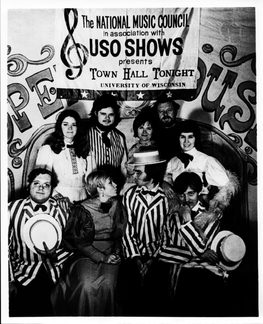 Joan Peterson, top row center, traveling with the USO in the early 1970s. Joan Peterson, top row center, traveling with the USO in the early 1970s. These USO tours gave us ample opportunity to explore the countries we were in, since we only performed one show a day, and that was invariably at night. This left the daytime for exploration. My husband and I were attracted to the colorful food markets, both indoor and outdoor ones, since we had become interested many years earlier in the cuisines of foreign countries and the new and unusual (to us) ingredients used in cookery around the world. The markets we particularly enjoyed were packed with vendors, each with a stall displaying a remarkable array of products. There always was a considerable amount of buying and selling activity, much of it quite boisterous, and I never tired of photographing these food stalls. 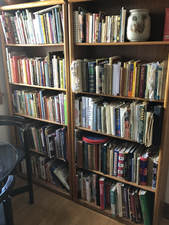 A peek at Joan and David Peterson's extensive cookbook collection. A peek at Joan and David Peterson's extensive cookbook collection. Our interest in international food can be traced back to membership in the University of Wisconsin League’s Foreign Foods interest group. Members and their spouses dined monthly on the cuisine of a foreign nation, each having cooked one of the meal’s courses. Members were just as enthused about choosing the countries as they were about planning the meals. A real bonus for me was that my husband became quite fascinated with cooking and took over the kitchen on a daily basis. This was also prompted by my inability to come home from the university in time to make dinner. I was a graduate student in science, and many of my experiments would not be completed until late in the evening--and there were two children to feed.
It's been a long time in the planning! Publisher and author Joan Peterson teamed up with chef and culinary expert William Wongso to take a group to get to the heart of Indonesian culture through an exploration of her tantalizing cuisine. Nine ladies from around the globe met us in Jakarta on August 4 and thus began our tasting adventure on the islands of Java and Bali. Those of us that flew on the same flight from LA were picked up by William Wongso, our co-leader for the tour. We stopped at Paradise Dynasty to sample their xiao long bao, and other delights. It was the perfect place to unwind and regroup after the long journey. After our early dinner we drove to the hotel to rest and get adjusted to the 12 hour time difference. August 5 - Jakarta Day 1 of our tour. This morning we met the rest of the group that took different flights and arrived at different times. We enjoyed our breakfast at the hotel, relaxed and were introduced to our co-host Astrid Enricka before heading out for lunch at Soto Pak Sadi. After lunch we stopped for coffee before heading to JAVARA Indonesian Spices. Inspired by Indonesia’s food biodiversity, indigenous wisdom and spiritualism, JAVARA was founded by Helianti Hilman in 2008. JAVARA works across agricultural value chains from production to distribution in order to preserve such biodiversity and bring community-based, organic products to broader markets. We are proudly investing our time to scout, discover and relive the forgotten food biodiversity and traditional techniques as well as the old recipes. Working with over 50,000 farmers and 2000 food artisans, selling over 600 premium artisan food products, JAVARA is currently known as the leading social enterprise in Indonesia that works with a vast range of biodiverse community-based organic food products using ethical principles. We stopped at MM Juice for an afternoon treat. We sampled durian juice, avocado juice and broken coconut juice and since it is a culinary tour, tried fried banana with cheese and banana cakes steamed in banana leaves. After a little rest and relaxation at the hotel we headed out for our 17-course dinner at Namaaz Dining. Namaaz is the first molecular gastronomy restaurant in Indonesia which serves Indonesian food as its signature dishes. Chef Andrian Ishak uses scientific techniques to produce both playful variations on traditional dishes and wacky new food pairing. Inspired by a multitude of art disciplines including music and painting, he considers himself as a craftsman that expresses his creativity through food.
As you all may have realized, we decided to cancel our 2016 Culinary Tour to Turkey. We are currently unsure as to whether or not we will offer a tour to Turkey in 2017. As I was updating the website, I realized I hadn't put up any photos from our 2015 tour! These don't seem to be in any particular order, but are a wonderful snapshot of the wonderful tour we offer to Turkey. Joan and I are extremely saddened not to be going to our beloved Turkey, but we will back soon! Thank you to everyone who stopped by to say hello to the authors and enjoy some samples made by the chefs at Metro Market. It was fun to share the Eat Smart Culinary Travel Guidebooks with our friends and neighbors at Metro Market. And a huge thank you to Metro Market for organizing the event! Can't wait to do it again!
Here are some highlights from our 2014 Culinary tour to Morocco. We had a wonderful time exploring the culinary delights. We enjoyed demonstrations and cooking classes, talks on culinary topics, and visits to bustling markets to learn about the herbs, spices and condiments that are prevalent in Moroccan cookery. And we also saw the major tourist sights, shopped and relaxed along the way! Balloon ride day! After breakfast at Les Maisons de Cappadoce, we went to Avanos and visited the ceramic factory followed by lunch at Aravan House. We visited the Goreme Open-Air Museum in the afternoon. We then went back to the hotel for some rest and relaxation before heading to the rooftop for a güzleme demonstration (and eating!) followed by our farewell dinner. It was warm enough in the evening to eat outdoors, so it was a splendid end to the day and to the trip.
|
AuthorWe write about food and travel. CategoriesArchives
October 2020
|



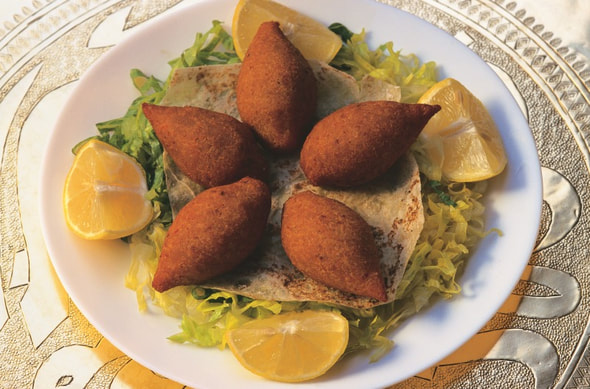

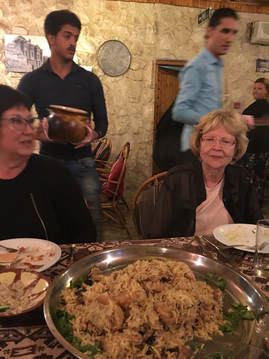
![By Sarah Canbel [CC BY-SA 4.0 (https://creativecommons.org/licenses/by-sa/4.0)], from Wikimedia Commons](/uploads/2/4/6/1/24613670/kanafeh-nabulsieh_orig.jpg)



























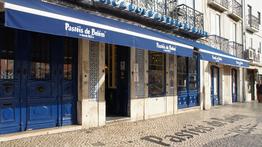
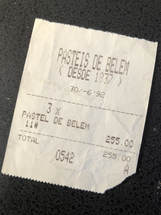
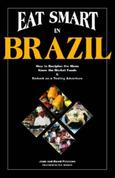
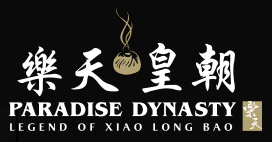

























 RSS Feed
RSS Feed